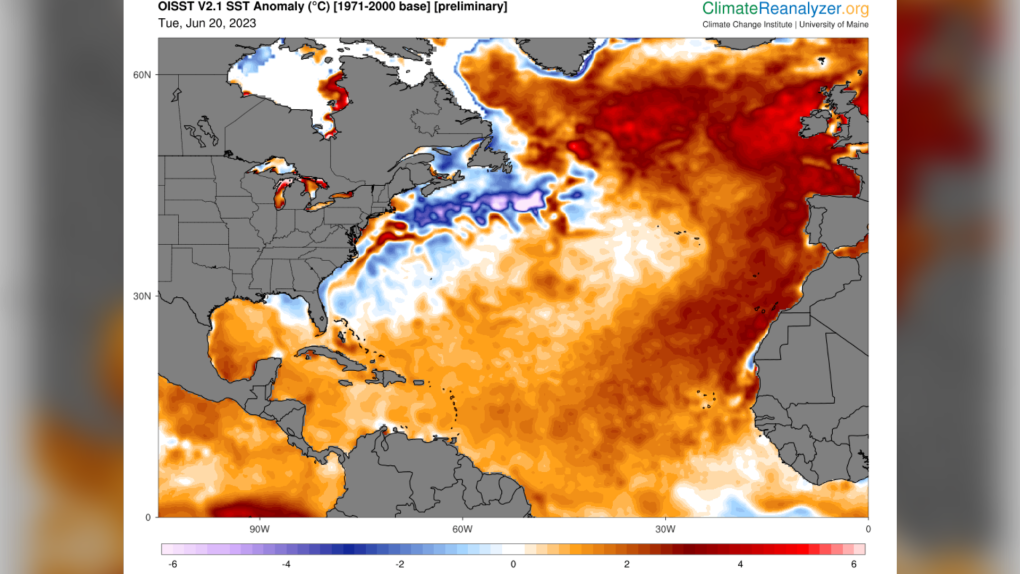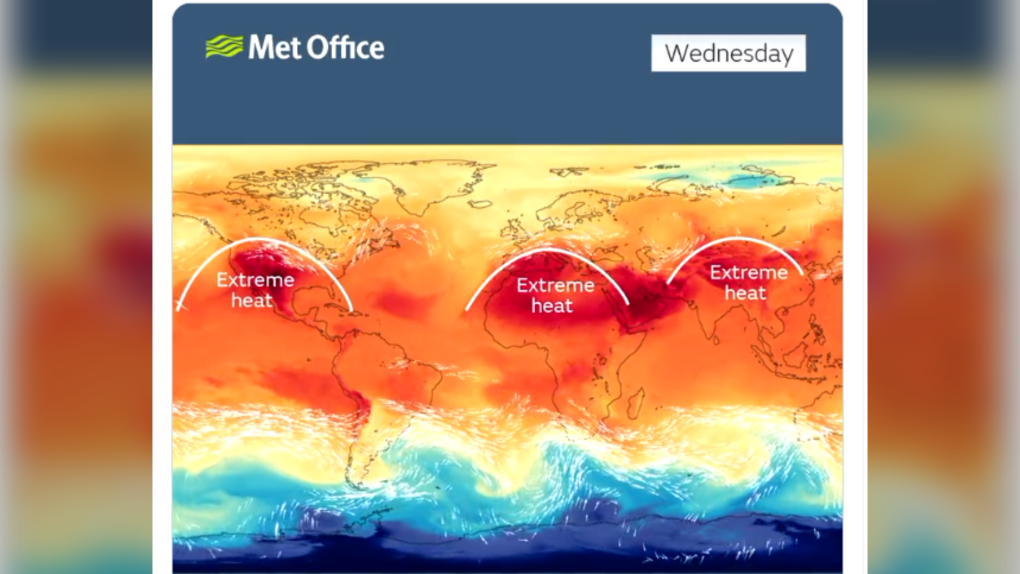Ocean water temperatures around Maritimes reaching record highs for July
A remarkable warming of ocean waters this July has some of the Atlantic marine districts reaching record highs.
Data provided by Peter Galbraith, a research scientist with the Department of Fisheries and Oceans (DFO), shows the average sea surface temperature in July is reaching record highs for eastern areas of the Grand Banks, the waters off the South Shore of Nova Scotia, and parts of the Bay of Fundy.
The waters off the South Shore of Nova Scotia, including parts of Lahave Bank and the Scotian Slope, are particularly remarkable. There the expected average for July 2023 is 17.4 C. That currently exceeds the standing record of 15.5 C set in 2022 by nearly 2 degrees. The Bay of Fundy is sitting at 14.85 C which is just over the record of 14.81 C set in 2022.
 Warm ocean waters are now present around the Maritimes. Most of these temperatures shown running 1 to 4 degrees above average for the month of July.
Warm ocean waters are now present around the Maritimes. Most of these temperatures shown running 1 to 4 degrees above average for the month of July.
There has been a marked turnaround in sea surface temperature anomaly from June to July for our ocean areas. While North Atlantic water temperatures were found to be at record highs in June most of our marine districts were actually sitting at or slightly below average for the month. Now halfway through July, according to data from the National Oceanographic and Atmospheric Association and DFO, most of those districts are sitting at 1 to 4 degrees above the monthly average.
 A sea surface temperature anomaly chart from June 20, 2023. The white and blues around the Maritimes indicating temperatures near or below average.
A sea surface temperature anomaly chart from June 20, 2023. The white and blues around the Maritimes indicating temperatures near or below average.
 A sea surface temperature anomaly chart from July 18, 2023. The reds around the Maritimes indicating temperatures well above average a marked difference from June.
A sea surface temperature anomaly chart from July 18, 2023. The reds around the Maritimes indicating temperatures well above average a marked difference from June.
What is the cause of the turnaround? According to Peter Galbraith sea surface temperatures in the western Atlantic are primarily influenced by atmospheric conditions, in other words, the weather.
From June into July the northern hemisphere has experienced several stagnant ridges in the jet stream. Those ridges have allowed heat domes to form allowing for extreme heat that has broken records in the southern US, southern Europe, and parts of the Middle East and Asia.
 A map from the UK Meteorological Office showing the current locations of the heat domes in the northern hemisphere.
A map from the UK Meteorological Office showing the current locations of the heat domes in the northern hemisphere.
While the Maritimes isn’t under one of those heat domes we have had a persistent ridge that has run up the eastern seaboard of the US and north of Atlantic Canada. That has allowed for a persistent southerly flow in the atmosphere moving very warm, humid air up from the subtropical Atlantic. The presence of that subtropical air warms the surface waters under it.
Waters could cool in the event of a cooler round of air arriving or, in the case of near coastal waters, a strong storm to create upwelling. Upwelling is the movement of cooler water at depth toward the surface. Neither of those scenarios look likely over the next several days and so the expectation is that by the end of July, our ocean waters will continue to be well above climate averages.
CTVNews.ca Top Stories

Mark Carney reaches out to dozens of Liberal MPs ahead of potential leadership campaign
Mark Carney, the former Bank of Canada and Bank of England governor, is actively considering running in a potential Liberal party leadership race should Justin Trudeau resign, sources tell CTV News.
This Canadian couple has been to 195 countries. Here's what they learned on their eight-year journey
Masha and Robert Glanville, a Canadian couple, sold everything they owned to travel the world full-time. With over 195 countries visited, they focus on mindful, eco-friendly travel and giving back. Here’s what they had to say about their global journey.
WATCH Woman critically injured in explosive Ottawa crash caught on camera
Dashcam footage sent to CTV News shows a vehicle travelling at a high rate of speed in the wrong direction before striking and damaging a hydro pole.
opinion Reflecting on 2024 and looking forward to 2025: a year of change for the Royal Family
There was no shortage of drama for the Royal Family in 2024. From illness to controversy over a doctored photo and brothers at war, royal commentator Afua Hagan recounts a pivotal year that altered the map of the monarchy's future and tested its strength like no other time in history.
'I gave them a call, they didn't pick up': Canadian furniture store appears to have gone out of business
Canadian furniture company Wazo Furniture, which has locations in Toronto and Montreal, appears to have gone out of business. CTV News Toronto has been hearing from customers who were shocked to find out after paying in advance for orders over the past few months.
Newfoundland residents seek answers, assurance as Quebec energy deal heads for debate
About 50 people gathered in a St. John's, N.L., gymnasium on a recent rainy night to seek answers about a massive energy deal with Hydro-Quebec trumpeted by the Newfoundland and Labrador government as a new chapter in the province's history.
Rideau Canal Skateway opening 'looking very positive'
As the first cold snap of 2025 settles in across Ottawa, there is optimism that the Rideau Canal Skateway will be able to open soon.
Much of Canada is under a weather alert this weekend: here's what to know
From snow, to high winds, to extreme cold, much of Canada is under a severe weather alert this weekend. Here's what to expect in your region.
Jimmy Carter's funeral begins by tracing 100 years from rural Georgia to the world stage
Jimmy Carter 's extended public farewell began Saturday in Georgia, with the 39th U.S. president’s flag-draped casket tracing his long arc from the Depression-era South and family farming business to the pinnacle of American political power and decades as a global humanitarian.

































